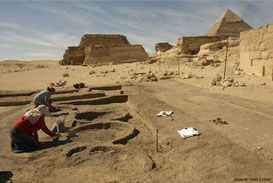March 6th, 3:00pm
The Barn. Spring Lodge Community Centre, Powers Hall End, Witham, Essex CM8 2HE
 Recent archaeological work at the 4th dynasty funerary complex of Queen Khentkawes, at Giza, has provided a new understanding of her priests’ ‘town’ and revealed a basin and valley complex.
Recent archaeological work at the 4th dynasty funerary complex of Queen Khentkawes, at Giza, has provided a new understanding of her priests’ ‘town’ and revealed a basin and valley complex.
The architectural layout of the ‘town’, and new information on its occupation, abandonment and formal re-occupation, indicate a site at the interface of sacred and secular, settlement and institution, desert and cultivation – hence ‘liminal’. The houses in the Khentkawes site are large but all the same size so showing no social hierarchy, which is very different (if we consider textual evidence) from ‘pyramid towns’. Further the administration of royal funerary cults, elsewhere, was carried out by a rotation of priests, probably occupying small houses on a temporary basis. In contrasts at the Khentkawes site the architectural layout suggests that the houses were occupied permanently by a priesthood of the same rank.
Finally we will look at the Khentkawes site in the broader context of other thriving settlements at Giza.
Ana Tavares is co-Field Director of Ancient Egypt Research Associates (AERA), working mainly on the Heit el-Ghurab settlement and Khentkawes site at Giza. She has worked extensively in Egypt, in site from Alexandria to Aswan, spanning the Early Dynastic to Islamic periods. Her main work has been settlement excavation in the Memphite area, and her interests are settlement, landscape and daily life.
